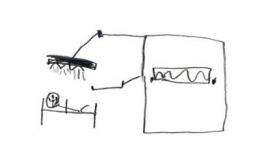Different methods can reduce hospital fear in children

Undergoing surgery can be a terrifying experience for a child. But stress and fear, and the use of pain relief after the procedure, can be reduced with simple means: drawings, continuity and dialogue. This has been shown by research at the Sahlgrenska Academy at the University of Gothenburg, Sweden.
Berith Wennström presents in her thesis interviews with children describing how they experienced being in hospital and undergoing surgery. The thesis also presents work in which, for example, saliva samples from 93 children aged between 5 and 11 years have been analysed, to measure the concentration of the stress hormone cortisol.
Special model
The children were assigned to one of three groups: children in the first group were taken care of in a conventional manner before the surgery, those in the second group received additional information of what was to happen on the day of the operation, and those in the third group were taken care of according to a special model known as "the perioperative dialogue" (PD).
Lower levels of stress
"The research showed than children who received care according to the PD model had lower levels of stress after the surgery and required less pain relieving morphine that children who had received conventional care", says Berith Wennström.
Unique experiment
The thesis presents also a unique experiment using a method based on analysing children's fear of hospital through drawings. Comparing the drawings of children in school with those in hospital allowed such features as a weak pen pressure, the use of few colours and poor use of the area on the page to be coupled with an increased anxiety in children who were to undergo day surgery.
Unpredictable situation
Interviews with children aged 6-9 years before and after day surgery are presented in the thesis. These interviews show that the children often feel compelled into an unpredictable situation in which they meet an unfamiliar world and must withstand hospital stress imposed on them. "The children initially attempt to gain control of the situation, and then they experience that they loose this when they become dizzy, for example, from sedatives."
Using the children´s language
In order to prevent fear and anxiety about the surgery, it is important to carry out a continuous dialogue with the children, and it is important that this takes place using the children's own language. Sedatives should not be routinely given: this must be the subject of careful individual assessment.
Important to minimise stress
"The thesis concludes that Swedish perioperative healthcare functions relatively well and supports children and their parents", says Berith Wennström. "But it is important to minimise stress and the fear of hospital in children before the surgery, and we must view the hospital situation from a child's perspective, if we are to succeed."
The thesis "Experiences, symptoms and signs in 3-11 year-old children undergoing day surgery in the context of the perioperative dialogue" was successfully defended on 11 November 2011.
The perioperative dialogue. The PD model is based on giving the child time to reflect on the impending surgery through continuity and dialogue, and allowing the nurse anaesthetist "sufficient" time and resources to be able to support the child and the family. The model includes, for example, preparative visits to the clinic such that the child meets a familiar face on the day of the procedure. Drawings can be used to facilitate dialogue with children who are to undergo day surgery, and as a way for the children to make themselves understood and communicate questions and feelings.















